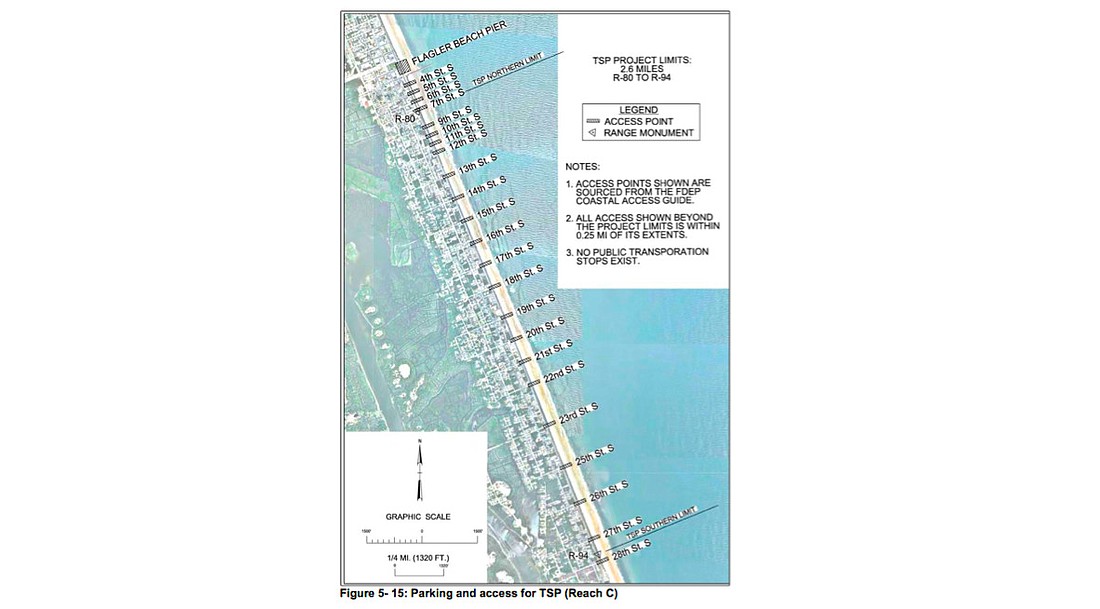- February 28, 2025

The Army Corps of Engineers is seeking public comment on its draft plan for beach renourishment in Flagler County, which involves extending dunes seaward about 10 feet along a 2.6-mile stretch of coast in Flagler Beach.
The Corps will host a public meeting about the plan at 6 p.m. Wednesday, Feb. 5, at the Emergency Operations Center, 1769 East Moody Blvd., Building 3.
The four-phase project would renourish the area between 7th Street and 28th Street in Flagler Beach, using sand dredged from a borrow site about seven miles offshore.
"After construction, we anticipate renourishement events would occur every 11 years to fix eroded areas," Corps Project Manager Jason Harrah said.
Each renourishment event, including the first one, will take 330,000 cubic yards of sand.
Harrah said the construction process, which involves pumping sand onto the beach, is “not a temporary fix,” and that it will armor and protect Oceanside Boulevard, the area’s main hurricane evacuation route.
Some dune vegetation will be covered in the initial construction, he said, but the Army Corps will plant similar vegetation once it’s over.
The federal government would pay 65% of the total project cost, and about 35% would be paid for by Flagler County, the Florida Department of Environmental Protection and the Florida Department of Transportation, Flagler County spokesman Carl Laundrie said.
Total cost for the initial phase of construction will be about $10,749,625, with most of that money — $9,182,550 — coming from the federal governmen, according to the Army Corps report
The total projected cost of the renourishment project over 50 years is $43,465,000, according to the Army Corps report.
The plan still has to make its way through a multi-tiered review process, and then be approved by Congress, before construction starts.
Flagler Beach City Commission Chairman Steve Settle said residents are concerned about delays in the federal process, and that the city has looked into alternative renourishment approaches in the past, such as artificial reef balls to trap sand, or underwater devices to deposit sand along the shore.
At the time, Settle said, the Army Corps was considering renourishing a longer stretch of beach, and the city feared the unwieldy project wouldn’t get off the ground.
“We didn’t think that we were likely to get some action for quite some time, if ever; that is why we started advocating for an alternative,” he said. “What we’ve got in this report is an alternative. It’s an alternative that entails just bringing the dune out about 10 feet.”
Settle said he felt the “best alternative would have been something that didn’t require a constant renourishment every few years,” but that the Army Corps has considered those approaches and decided the plan they suggested is the most feasible for Flagler Beach.
“Is it the alternative that, in the best of all worlds, we would have liked to see? No. But is it the most feasible? According to the federal report, it seems that it is,” he said.
The Army Corps’ study team, Harrah said, also evaluated possibilities such as shore protection with seawalls or revetments, or with soft structures like beach nourishment or geotubes.
Settle said Flagler Beach Commissioners will attend the Feb. 5 meeting and will also meet with Flagler County Board of County Commissioners about the plan at a later date, he said.
Tell the Army Corps of Engineers what you think:
The Army Corps of Engineers, Jacksonville District has asked the public to review and comment on the draft Flagler County Hurricane and Storm Damage Reduction Study. A public meeting about the plan will be held 6 p.m. Wednesday, Feb. 5, at the Emergency Operations Center, at 1769 East Moody Blvd., building 3.
During the 30-day public comment period, which ends Feb. 17, residents can also send comments to [email protected] or by mail to U.S. Army Corps of Engineers, Jacksonville District, Attn: Kathleen McConnell (CESAJ-PD-EC), 701 San Marco Boulevard, Jacksonville, FL 32207.
Copies of the report are online on the Flagler County website and in the Flagler County and Flagler Beach libraries and Flagler Beach City Hall.
To view the report on the Flagler County website, visit http://www.flaglercounty.org/ArchiveCenter/ViewFile/Item/3417.